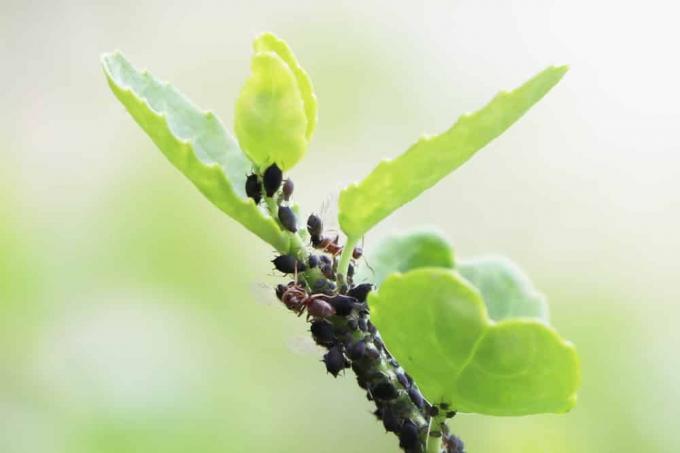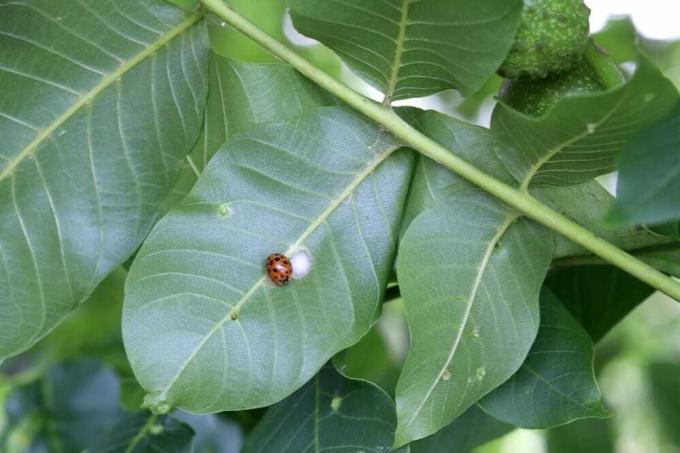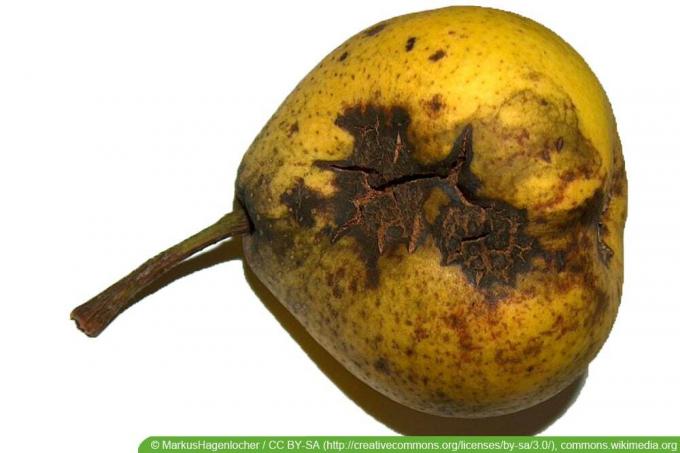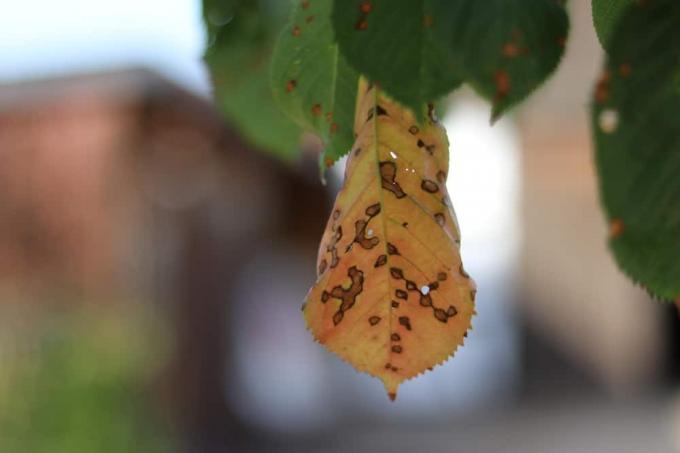

Table of contents
- Better safe than sorry
- Walnut Tree Diseases
- Cherry leaf roll virus
- Powdery mildew (Erysiphaceae)
- fungal infection
- bacterial infection
- Walnut Tree Pests
- aphids
- caterpillars
- Walnut fruit fly (Rhagoletis completa)
With its magnificent foliage, the walnut tree is a real eye-catcher in summer. It not only provides shade, but also rewards plant lovers with a lush walnut harvest. However, healthy growth is a prerequisite. Although it is one of the most robust tree species, some pests and diseases can still make life difficult for it. You can find out what these are and how to combat them in the following guide.
Better safe than sorry
The real walnut tree or common walnut tree, popularly known as walnut tree for short, is a strong and robust specimen when healthy. It has a natural defense organism that protects it extensively from diseases and numerous pests. But there is never 100 percent protection for plants, so the Juglans regia can also be affected.
At the beginning of every illness and pest infestation, he exerts all his strength against it. However, the course of the disease should not be stopped and pests can multiply unhindered as well as the Withdrawing life energy often means that not only does the nut harvest fail, but the walnut tree can go into a life-threatening state danger.
Tip:
For the reasons mentioned, this robust walnut plant should be checked regularly for possible diseases and pests, so that you can act quickly and prevent worse things from happening by fighting - in some cases there is unfortunately no effective one combat.
Walnut Tree Diseases
Here are the typical diseases that can affect a walnut tree:
Cherry leaf roll virus
The cherry leaf roll virus is also under the name Walnut Blackline Disease known. This is an infectious disease that progresses slowly and can lead to death, especially in weakened trees.

Recognize
- Yellow line patterns and yellow spots on the leaves and fruit
- Fruit and leaves fall off
- Black line formations on woody areas
- Dead tissue forms on the grafted branches
- branches dried up
- No more new shoots form
combat
Effective control is not known to date. The virus spreads internally so quickly that even cutting off affected areas is already too late when the first signs are visible.
Powdery mildew (Erysiphaceae)
The walnut tree is particularly susceptible to powdery mildew in the dry months and in the warm summer. In contrast to downy mildew, which only prefers humid climates, powdery mildew is also known as the "fair weather fungus", although moisture does not deter it. Powdery mildew is a pseudo fungus that can be easily controlled if treated quickly. It is called a pseudofungus because it leaves a corresponding image behind, but is more related to brown and diatoms.
Recognize
- In the initial stage only white, sticky fungal coating on the upper side of the leaves
- Later in the course of the disease, a white carpet of fungus can also be seen on the underside of the leaves
- It then migrates to all green plant parts
- Coating becomes brownish to greyish over time
- Wasted infructescence
- Some leaves turn up the side edges
- Leaves dry up and fall off
- If powdery mildew is left untreated, it can penetrate into the tree trunk and cause it to die off
combat
There are various methods to combat powdery mildew on walnut trees, all of which have proven to be effective.
soapy water
- Depending on the size of the infestation and the tree, dilute the appropriate amount of water with soap
- Only soaps without chemical additives are suitable as soap
- Pour soapy water into a pointed pump
- Spray the foliage dripping wet with the soapy water
- Make sure that all parts of the plant are sprayed from each side
- If the white fungus carpets have not disappeared after five to six days, repeat the process
- Do not spray in full sun or in the hot midday sun
- A dry day should be chosen for spraying - it is optimal if further dry days follow so that the soapy water can take effect and is not washed away by rain
crop protection products
A plant protection product against powdery mildew is available in any specialist shop. Here you should make sure that nocturnal sulfur or other organic active ingredients are included. If you spray the walnut tree with it every year before flowering, you will keep powdery mildew away. If this has already spread to the tree, a pesticide is one way to combat it. Even if it is in the organic ingredients, a treatment is an existing infructescence less advisable, since the liquid gets inside the fruit and eating the fruit does not is recommended. The soapy water, on the other hand, can be used without hesitation.
fungal infection

There are countless species of mushrooms that settle in gardens every year. Some are more stubborn to fight and show severe and sometimes life-threatening damage, while others have little effect on the walnut tree. But in any case, you should react, because it is almost impossible to identify exactly which fungus it is. An expert can certainly help you on site, but combating it immediately will solve the problem even without knowing the fungus by name. As a rule, walnut trees show more or less the same symptoms when infested with fungus.
Typical features of a fungal infestation
- Brown and greyish-brown leaf discolouration
- Curled and/or stunted leaves
- Leaves dry and fall off more often
- growth disorders
- New shoots fail or grow very thin
- Thin green twigs hang down powerlessly
- Often smears on the leaves and/or on the green branches
- Trees are thinning out
- Infructescences are absent, do not develop properly or fall off unripe
combat
fungicides
The quickest and most effective are usually fungicides that are available for purchase in specialist shops especially for use in treating fungi. It is recommended to only use organic products here. Most of them ensure that the fruit remains suitable for consumption despite spray treatment. In addition, treatment with organic fungicides is environmentally friendly. When using chemical products, you must reckon with contamination with the walnuts. The extent to which these could endanger your health when eating walnuts depends on the respective ingredients and dosages. It should also be taken into account that chemical fungicides are also poisonous for insects and should therefore only be used under special precautions are used - or just do without and only a bio-fungicide for fungus control use.
Exception tree fungus infestation
In addition to the tiny fungal spore infestation of various types of fungi, tree fungal infestation can also occur. This can be seen far more often. Proper fungus sponges usually form on the tree trunk. These are not always edible and not always harmful to the walnut tree. Nevertheless, you should become active.
- As soon as you suspect the first signs of a possible tree fungus infestation, you should remove them so that the fungus does not spread
- Score the bark/wood with a sharp knife
- If the tissue is green, combat can still be effective
- If the inner tissue has dried up or shimmers yellowish-green, the fungus is already inside
- In this case, control with conventional measures is not possible
- It is advisable to consult an expert, if necessary from the plant protection office
- He can explicitly assess what needs to be done or whether a felling is necessary
bacterial infection
Bacterial infestations are repeatedly found in walnut trees, which in the worst case can even kill large, strong trees. Bacterial transmission typically occurs through the use of infected pruning tools and large pruning wounds that allow bacteria to enter the tree.
Recognize
Growths usually form on branches or the trunk as a result of a bacterial infection. These can become immense and cause holes, especially on the trunk. The so-called tree cancer usually results from a bacterial infestation.
Fight
In many cases it is sufficient to cut out the growths over a large area. If they are hanging on a branch, cut it back until fresh green appears inside. This is a sure sign that the area is (still) healthy. Then the interfaces are to be covered with coal ash or special resin for wound closure in plants. This way no new bacteria can enter.
Tip:
Always use disinfected cutting tools when pruning trees. Only cut on dry days and always close larger cut surfaces to avoid bacterial contamination.
Walnut Tree Pests
These pests are to be expected on the walnut tree:
aphids

Damage from aphids can only be expected if there is a large infestation and the leaves are curling up. Otherwise, the Julians regia gets along well.
Recognize
In order to spot aphids, you would have to get quite close to the leaves, as the small, brown, black or greenish animals, which are only a few millimeters in size, are hardly visible. You can use the following signs as a guide:
- Sticky coating on leaves (honeydew)
- Rolled up and partly stunted leaves
- Yellow leaves
- Leaves dry up and fall off
- Mostly seen in colonies, especially on new shoots
Fight
- If the infestation is manageable, cut off the affected branches down to the healthy area
- Then spray the tree with high pressure (washes down any animals that are still there)
- In the case of severe, large-scale infestation, prepare highly concentrated soapy water
- Add about 500 milliliters of rapeseed oil for every ten liters of soapy water (glues the respiratory organs of the aphids)
- Spray the tree until dripping wet
- Repeat the process after about three days
caterpillars
You like to tamper with blue sieve, willow borer and butterfly caterpillars on walnut trees. Blue sieve caterpillars, in particular, often leave behind massive damage. They have a yellowish-white body up to six centimeters in size, on which there are so-called point warts. If they have eaten their way into branches and trunks, they form a hollow tunnel system there.
combat
When fighting, it is important that you do this early on, before the caterpillars have worked their way into the tree interior. Once they get there, you can no longer reach them and combat them is impossible.
collect
If there are not too many caterpillars and the walnut tree is not very tall, you can collect the caterpillars by hand. Another variation is shaking down. To do this, place a foil on the ground and either shake the still small tree or work your way from branch to branch with a broom, for example. You can then dispose of the caterpillars that have fallen on the foil in the household waste.
Cut
If it is a light infestation in the early stages and the caterpillars are on the branches, you can remove them from the walnut tree by cutting off the affected branches. Telescopic pruning shears are advantageous for tall specimens.
neem oil
There are commercially available neem oil plant products that you can use to effectively control caterpillars on walnut trees. You spray the tree or only the affected parts of the plant with it. The neem oil gets lodged in the caterpillars' airways, causing them to suffocate.

Walnut fruit fly (Rhagoletis completa)
The walnut fruit fly is not the direct problem, but the maggots. From about July/August they lay their eggs in the fruit shells. As a result, they leave black dots on the green fruit skins. The maggots penetrate through the pericarp and eat it. A distinct feature is a soft, moist fruit that more or less dries up as it progresses. Because they only penetrate the pulp, the walnuts can still be eaten as long as they are not completely dry. All you have to do is remove the black pulp from the nut.
combat
Collect fallen walnuts daily and either remove the nut immediately or discard it. This prevents pupation and the walnut fruit fly does not reproduce. Cherry fruit fly traps can be hung in the treetop and should be replaced or cleaned daily. If you put a close-meshed net around the walnut tree from June, you will also prevent walnut fruit flies from getting into the branches to lay their eggs in the fruit shells.
 garden editorial
garden editorial I write about everything that interests me in my garden.
Learn more about plant diseases

White spots on leaves: what to do?
Whether in the home or in the garden, white spots on the leaves of your favorite plants are always a cause for concern. However, the causes can often be eliminated quickly. This guide summarizes the most common triggers and gives tips for quick help.

Recognizing pear scab & biological control
Pear scab (Venturia pyrina) is a disease of pears caused by a fungus. It leads to spots on the young fruits, which are then shed or stunted. Read here how to fight or avoid the disease.

Wilted leaves on cucumbers: cause cucumber wilt - what to do?
Wilted leaves on cucumbers are not uncommon, because the plants are sensitive and susceptible to diseases. However, if the cause is cucumber wilt, appropriate measures must be taken and other plants protected as well. We tell you what to do here.

Common leaf diseases on fruit trees
A fruit tree in the garden is somehow part of it. Due to the different forms of training of the trees, they can also be found in the smallest garden. Whether columnar fruit, espalier fruit, a naturally grown fruit tree or a new breed with different varieties on one trunk, there is some kind of fruit tree in almost every home garden. The garden owners who have space for several can be happy. As beautiful as the fruit trees are, with their blossoms in spring, their dense foliage in summer and fruit in autumn, they are also often plagued by diseases.

Plant diseases on indoor plants - recognize and combat
Numerous plant diseases are caused by microscopic organisms, including bacteria, fungi and viruses. These penetrate plant cells and damage the entire plant, often fatally. In addition, animal pests can also extremely weaken indoor plants. Early detection and immediate remedial measures are important in order to save infested plants.

Ground cover roses: care from A – Z
All varieties of ground cover roses are attractive plants with an abundance of flowers consisting of single or double, single or multicolored and delicately scented flowers. Sometimes they even bloom several times a year. They are a low-maintenance and pretty alternative to green ground covers.
